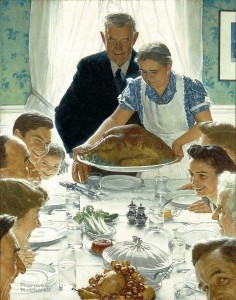
Norman Rockwell (1894-1978), Freedom from Want, 1943. Oil on canvas, 45 3/4″ x 35 1/2″. Story illustration for The Saturday Evening Post, March 6, 1943. Norman Rockwell Museum Collections. ©SEPS: Curtis Licensing, Indianapolis, IN.
There are works of art that have become iconic, which come to represent something in our culture. Freedom From Want, by Normal Rockwell is one of those. It’s arguably the template upon which we base our family Thanksgiving meals across the country – an iconic image we look to on that most iconic of American family gatherings.
Here’s the original. Click on it to see a larger version. A quintessential view of family united for Thanksgiving. The slideshow below has many reinterpretations, each pointing to some aspect of our culture. Some are serious, some ridiculous. Some commercial, some political. But all show the power of this painting in our collective self image.
If you didn’t know, I’m a big fan of covers, homages, and reinterpretations of different forms of art. I have a growing collection of YouTube playlists of different versions of the same song, for example. Here’s my little collection of versions of Norman Rockwell’s iconic painting Freedom From Want. If you’d like to see it on Flickr, you can click here. What else represents our collective image of American Thanksgiving so well? And these different versions of this painting humorously, sarcastically, insightfully and sometimes maybe randomly comment on that idea of what Thanksgiving really is. If you come across Far From Want reinterpretations and homages I’ve missed, please put them in the comments. And have a great Thanksgiving. 
Here’s a great story of the origin of Rockwell’s painting, it’s inspiration, use and reception. To summarize, President Roosevelt delivered the speech that’s embedded below on January 6, 1941 outlining the four freedom’s worth fighting for. Two years later The Saturday Evening Post published essays and Rockwell paintings about each of them.
Here’s the essay that accompanied Norman Rockwell’s painting in The Saturday Evening Post. You can imagine the controversy over this essay with portions of it saying things like:
But we are not really free unless we use what we produce. So long as the fruit of our labor is denied us, so long will want manifest itself in a world of slaves.
This was a time when democracy in America started to seem a bit like socialism, with all of it’s social programs, and the serfs and slaves and poor had a voice they had long demanded, and had fought for abroad as anarchists and communists and had demanded in the US.
But to dismiss this as a leftist essay is to do it a disservice. I want to quote so much of it I’d put the whole thing here. It’s a cry for us all to unite for love, and justice and humanity. It’s a definition of America not just as a country or a place, but an ideal. It’s really a beautiful essay and I hope you give a read. Here’s one more quote.
It is the dignity of the individual to live in a society of free men, where the spirit of understanding and belief exists; of understanding that all men, whatever their color, race, religion or estate, should be given equal opportunity to serve themselves and each other according to their needs and abilities.
And I hope you have a great Thanksgiving. 




The KFC bucket with grandma having a cigarette is always my favorite. Nice compilation!